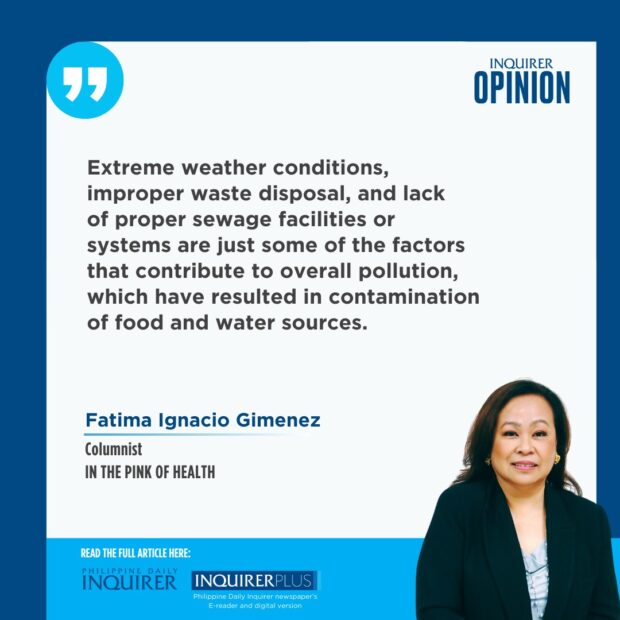
Be careful of what you drink or eat, or in this case, swim in. Aside from the opening ceremonies in the Paris 2024 Olympics which triggered a backlash and was eventually dismissed with a diluted and anemic apology, one remark from an athlete about neglect of personal hygiene such as the non-washing of hands building up one’s own immunity is also up for debate.
Joke or not, it isn’t a laughing matter or to be taken lightly. In a world that is fast losing its grip on right and wrong, black or white, this is definitely not a gray area. Discussions on exposure and immunity bring back a two-decade-old memory of a cousin who called to share that my nephew and her only child were being invited to a “chicken pox party.“ My remark then was, “Are they for real? Aren’t they taking it to such extremes? Hard to believe as you are living in a ‘first world country’.”
Extreme weather conditions, improper waste disposal, and lack of proper sewage facilities or systems are just some of the factors that contribute to overall pollution, which have resulted in contamination of food and water sources. With the advent of the rainy season, allow me to give you a briefer on several diseases that have been a cause of outbreaks, some of which you may be familiar with, or unfortunately must have experienced personally.
Escherichia coli. E.coli causing diarrhea is classified into five strains, some of which are more common in resource-limited countries. Diarrhea is either bloody or watery and the incubation period may be as short as 10 hours to as long as six days. It can be accompanied by abdominal pain and fever, may be self-limiting, or become chronic, causing wasting and malnutrition. For the toxin-producing strain, this may require hospitalization as severe cases can lead to neurologic, hematologic, and renal dysfunction.
Salmonella. This is a bacteria that can be transmitted from humans and warm-blooded animals. You may be familiar with enteric fever, more commonly known as typhoid fever, but there is also a separate entity labeled as non-typhoidal Salmonella, with gastroenteritis as the most common associated illness. The latter has been linked in more developed countries to products of animal origin such as beef, poultry, dairy products, eggs, or from contact with infected animals such as hamsters, turtles, and pet iguanas to name a few. Infection for both can lead to invasive or focal infections and may be particularly severe for the immunocompromised and young children. For typhoid fever, prolonged untreated illness may lead to intestinal perforation. Asymptomatic carriage is also possible. You may have heard of “Typhoid Mary” who worked as a cook in the 1900s and was infamous for having infected quite a number of individuals. It is worthwhile to read her story.
Hepatitis A. This is a virus that may be transmitted via the fecal-oral route or from person to person. Symptomatic infections present with fever, malaise, anorexia, nausea, and jaundice which are more commonly seen in adults and older children. This condition is self-limiting and individuals are most infectious one to two weeks before jaundice appears. From current data, outbreaks have been associated more with raw produce such as oysters, mussels, and fruits, and from water that has been inadequately treated or contaminated with sewage.
Norovirus. Aside from sapovirus, this etiologic agent had its share of the limelight in January of this year as a cause of the reported outbreak in Baguio. Watery diarrhea and vomiting are typically abrupt in onset and may be accompanied by abdominal pain, fever, headache, or malaise. Infection may be acquired via the fecal-oral route through food, water, touching surfaces, or even vomitus containing the virus. Incubation period is short with symptoms lasting from 24 to 72 hours.
Prevention. Handwashing is still the most effective preventive measure to avoid acquiring the infection. Among the diseases mentioned, there are commercially available vaccines for hepatitis A and typhoid fever. One unforgettable advice that a pediatric infectious disease expert on travel medicine shared was to avoid partaking in ice when in places with questionable water sources. Hearing this, my eyes unconsciously strayed from her plate to her glass over dinner in the five-star hotel where we had her billeted. I took no offense.
In unfortunate instances that you do become ill, please remember that you are a potential source of infection. While you may escape unscathed or recover from the moderate or even severe dehydration that may occur, this may not be the course for some that you may inadvertently affect particularly very young children, the elderly, and the immunocompromised. Treatment is basically supportive and self-medication with antibiotics is not advised unless under the supervision of a health professional.
timgim_67@yahoo.com

